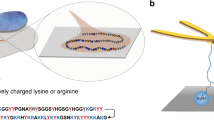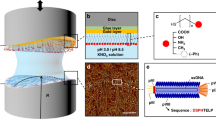Abstract
The ability to control the interaction of polyelectrolytes, such as DNA or proteins, with charged surfaces is of pivotal importance for a multitude of biotechnological applications. Previously, we measured the desorption forces of single polymers on charged surfaces using an atomic force microscope. Here, we show that the adhesion of DNA on gold electrodes modified with self-assembled monolayers can be biased by the composition of the monolayer and externally controlled by means of the electrode potential. Positive potentials induced DNA adsorption onto OH-terminated electrodes with adhesion forces up to 25 pN (at +0.5 V versus Ag/AgCl), whereas negative potentials suppressed DNA adsorption. The measured contributions of the DNA backbone phosphate charges and the doubly charged terminal phosphate on adsorption agreed with a model based on the Gouy–Chapman theory. Experiments on an NH2-terminated electrode revealed a similar force modulation range of the coulomb component of the desorption force. These findings are important for the development of new DNA-based biochips or supramolecular structures.
This is a preview of subscription content, access via your institution
Access options
Subscribe to this journal
Receive 12 print issues and online access
$259.00 per year
only $21.58 per issue
Buy this article
- Purchase on Springer Link
- Instant access to full article PDF
Prices may be subject to local taxes which are calculated during checkout




Similar content being viewed by others
References
Rothemund, P. W. K. Folding DNA to create nanoscale shapes and patterns. Nature 440, 297–302 (2006).
Jungmann, R., Liedl, T., Sobey, T. L., Shih, W. & Simmel, F. C. Isothermal assembly of DNA origami structures using denaturing agents. J. Am. Chem. Soc. 130, 10062 (2008).
Kuhner, F., Erdmann, M. & Gaub, H. E. Scaling exponent and Kuhn length of pinned polymers by single molecule force spectroscopy. Phys. Rev. Lett. 97, 218301 (2006).
Kuhner, F. et al. Friction of single polymers at surfaces. Langmuir 22, 11180–11186 (2006).
Chatellier, X., Senden, T. J., Joanny, J. F. & di Meglio, J. M. Detachment of a single polyelectrolyte chain adsorbed on a charged surface. Europhys. Lett. 41, 303–308 (1998).
Hugel, T. et al. Elasticity of single polyelectrolyte chains and their desorption from solid supports studied by AFM based single molecule force spectroscopy. Macromolecules 34, 1039–1047 (2001).
Seitz, M., Friedsam, C., Jostl, W., Hugel, T. & Gaub, H. E. Probing solid surfaces with single polymers. ChemPhysChem. 4, 986–990 (2003).
Rant, U. et al. Dynamic electrical switching of DNA layers on a metal surface. Nano Lett. 4, 2441–2445 (2004).
Rant, U. et al. Switchable DNA interfaces for the highly sensitive detection of label-free DNA targets. Proc. Natl Acad. Sci. USA 104, 17364–17369 (2007).
Lahann, J. et al. A reversibly switching surface. Science 299, 371–374 (2003).
Marko, J. F. & Siggia, E. D. Stretching DNA. Macromolecules 28, 8759–8770 (1995).
Chiu, T. K. & Dickerson, R. E. 1 angstrom crystal structures of B-DNA reveal sequence-specific binding and groove-specific bending of DNA by magnesium and calcium. J. Mol. Biol. 301, 915–945 (2000).
Bai, Y. et al. Quantitative and comprehensive decomposition of the ion atmosphere around nucleic acids. J. Am. Chem. Soc. 129, 14981–14988 (2007).
Schildkraut, C. & Lifson, S. Dependence of melting temperature of DNA on salt concentration. Biopolymers 3, 195–208 (1965).
SantaLucia, J. A unified view of polymer, dumbbell and oligonucleotide DNA nearest-neighbor thermodynamics. Proc. Natl Acad. Sci. USA 95, 1460–1465 (1998).
Lee, L., Johnston, A. P. R. & Caruso, F. Manipulating the salt and thermal stability of DNA multilayer films via oligonucleotide length. Biomacromolecules 9, 3070–3078 (2008).
Bard, A. J. & Faulkner, L. R. Electrochemical Methods: Fundamentals and Applications (Wiley & Sons, 2000).
Christie, J. H. & Lingane, P. J. Theory of staircase voltammetry. J. Electroanal. Chem. 10, 176–182 (1965).
Ferrier, D. R. & Schroeder, R. R. Staircase voltammetry with varied current sampling times—theory for diffusion controlled, rate controlled, and mixed rate and diffusion controlled electrode reactions. J. Electroanal. Chem. 45, 343–359 (1973).
Zipper, J. J. & Perone, S. P. Theoretical and experimental evaluation of staircase voltammetry. Anal. Chem. 45, 452–458 (1973).
Bustamante, C., Marko, J. F., Siggia, E. D. & Smith, S. Entropic elasticity of lambda-phage DNA. Science 265, 1599–1600 (1994).
Netz, R. R. & Joanny, J. F. Complexation behavior of polyampholytes and charged objects. Macromolecules 31, 5123–5141 (1998).
Lehninger, A., Cox, M. & Nelson, D. L. Lehninger Principles of Biochemistry (W. H. Freeman & Co., 2008).
Kosenkov, D., Gorb, L., Shishkin, O. V., Sponer, J. & Leszczynski, J. Tautomeric equilibrium, stability and hydrogen bonding in 2'-deoxyguanosine monophosphate complexed with Mg2+. J. Phys. Chem. B 112, 150–157 (2008).
Sonnenberg, L., Parvole, J., Kuhner, F., Billon, L. & Gaub, H. E. Choose sides: differential polymer adhesion. Langmuir 23, 6660–6666 (2007).
Friedsam, C., Seitz, M. & Gaub, H. E. Investigation of polyelectrolyte desorption by single molecule force spectroscopy. J. Phys. Condens. Matter 16, S2369–S2382 (2004).
Netz, R. R. & Joanny, J. F. Adsorption of semiflexible polyelectrolytes on charged planar surfaces: charge compensation, charge reversal and multilayer formation. Macromolecules 32, 9013–9025 (1999).
Rentsch, S., Siegenthaler, H. & Papastavrou, G. Diffuse layer properties of thiol-modified gold electrodes probed by direct force measurements. Langmuir 23, 9083–9091 (2007).
Manning, G. S. Molecular theory of polyelectrolyte solutions with applications to electrostatic properties of polynucleotides. Q. Rev. Biophys. 11, 179–246 (1978).
Maier, B., Seifert, U. & Radler, J. O. Elastic response of DNA to external electric fields in two dimensions. Europhys. Lett. 60, 622–628 (2002).
Widrig, C. A., Chung, C. & Porter, M. D. The electrochemical desorption of N-alkanethiol monolayers from polycrystalline Au and Ag electrodes. J. Electroanal. Chem. 310, 335–359 (1991).
Ross, S. & Morrison, I. D. Colloidal Systems and Interfaces (Wiley & Sons, 1988).
Chen, Z. & Singh, R. K. General solution for Poisson–Boltzmann equation in semiinfinite planar symmetry. J. Colloid Interface Sci. 245, 301–306 (2002).
Evans, E. & Ritchie, K. Dynamic strength of molecular adhesion bonds. Biophys. J. 72, 1541–1555 (1997).
Smith, S. B., Cui, Y. J. & Bustamante, C. Overstretching B-DNA: The elastic response of individual double-stranded and single-stranded DNA molecules. Science 271, 795–799 (1996).
Rief, M., Clausen-Schaumann, H. & Gaub, H. E. Sequence-dependent mechanics of single DNA molecules. Nature Struct. Biol. 6, 346–349 (1999).
Horinek, D. et al. Peptide adsorption on a hydrophobic surface results from an interplay of solvation, surface and intrapeptide forces. Proc. Natl Acad. Sci. USA 105, 2842–2847 (2008).
Acknowledgements
The authors would like to thank R. Netz, D. Ho, T. Hugel, W. Schuhmann and G. Papastavrou for helpful discussions. This work was supported by the German Science Foundation (SFB 486) and the Nanosystems Initiative Munich (NIM). A.F. thanks the Alexander von Humboldt Foundation for their generous support.
Author information
Authors and Affiliations
Contributions
M.E., A.F. and H.E.G. conceived and designed the experiments and co-wrote the paper. M.E. performed the experiments and analysed the data. R.D. contributed the dsDNA and provided the tip and electrode functionalization. All authors discussed the results and commented on the manuscript.
Corresponding author
Ethics declarations
Competing interests
The authors declare no competing financial interests.
Supplementary information
Supplementary information
Supplementary information (PDF 797 kb)
Rights and permissions
About this article
Cite this article
Erdmann, M., David, R., Fornof, A. et al. Electrically controlled DNA adhesion. Nature Nanotech 5, 154–159 (2010). https://doi.org/10.1038/nnano.2009.377
Received:
Accepted:
Published:
Issue Date:
DOI: https://doi.org/10.1038/nnano.2009.377
This article is cited by
-
Reagentless biomolecular analysis using a molecular pendulum
Nature Chemistry (2021)
-
DNA origami-based shape IDs for single-molecule nanomechanical genotyping
Nature Communications (2017)
-
Deceleration of single-stranded DNA passing through a nanopore using a nanometre-sized bead structure
Scientific Reports (2015)
-
Tuning the translational freedom of DNA for high speed AFM
Nano Research (2015)
-
Protein analysis by time-resolved measurements with an electro-switchable DNA chip
Nature Communications (2013)



